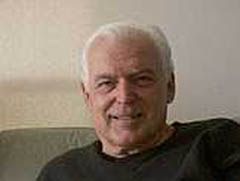This is a story about David Seculoff, who,
disguised as a mild-mannered, part-time doorman
during the day, becomes a mild-mannered
clarinetist and abstract painter off the clock.
And, shhhh … he is reticent to talk about any
of it. He doesnt even practice it all that much,
so lets just keep it between us, okay?
This sixty-ish, cosmopolitan painter –
reluctant to talk about his work, tight-lipped
for sure and a challenge to enquiring journalists
anywhere – is nonetheless, an unsung talent
deserving of attention.
“I’m not telling stories with my work,” the
handsome, manicured artist confessed recently in
his mid-town studio apartment. Subtly distancing
himself from the dominant figurative field of
local works, he adds, “I really just manipulate
puddles of color until I’m satisfied. The (he
refers to them in the third-person) works refer
only to themselves.”
And, with such – responses, we’re left to string
together a mosaic of underlining elements that
might help us address his painted works which
have been shown and collected internationally as
well as most recently at Artlink.
His paintings, large, 4 by 5-foot expanses on
special paper (he needs to secure it out of
Chicago; it’s unavailable here and no local
outlets will order it for him, duh?) absorb his
deep, but not dark, brooding colors. He applies
the paint via a roller, but sometimes it’s nudged
or dripped. The images resemble cast imprints
from peeling billboards and posters. They mimic
the residue of weathered exterior walls or eroded
pedestrian pathways, all the while incorporating
geometric, hard-edged shapes.
Intriguing, enigmatic, the stuff of abstract
painters. Perhaps his images are guided via a
kind of Jungian subconscious, ambiguous symbols,
land- or dream-scapes, whatever, they are
contemplative and restorative.
Born of highly driven immigrant Macedonian
parents, Seculoff was exposed to music and art
appreciation from the onset. His parents,
particularly his father, were determined to
provide an old-world upbringing including the
fine arts, and he and his five siblings were
exposed to music and literature.
After working in several trades including a
career as a baker, the elder Seculoff and his
wife opened a restaurant originally called The
Palace of Sweets, later Tom and Johnnies, on West
Main Street, with Mrs. Seculoff doing the
cooking. Years later the family sold the
business, and it is now the site of
O’Sullivans.
During his school days (he eventually played in
the band and orchestra during high school at
Central Catholic) David pursued the clarinet and
was able to master it to the point that he played
with the Fort Wayne Philharmonic under his
mentor, the former renowned conductor, Igor
Buketoff.
From there he graduated to extra curricular
classes in Chicago and parlayed a scholarship to
the Thornton School of Music at the University of
Southern California following a stint in the Army
during the Korean War. Although he maintained his
abiding interest in music at USC (he actually
played a bagpipe at one point), Seculoff
considered becoming a writer and ended up earning
his undergraduate degree in the Humanities. Two
years later he would earn a MFA.
Although he himself never took a painting class
from him, Seculoff remembers the legendary
painter Richard Diebenkorn, mostly from stories
through friends who took his classes at USC.
“It made sense to me,” he recalled “that
Diebenkorn would require his students to produce
a painting each day of class. It was a way to
teach younger artists not to be precious, to
loosen up and not to be so attached. I’m not
certain the students liked it.”
Interestingly, while living in Hermosa Beach
Seculoff became a neighbor of the famous artist
and would occasionally catch a glimpse of him
working on a piece on his balcony.
“I was far too timid to ever approach him,” Seculoff remembered.
“It was an interesting period then in all the
arts,” he continued. “Charles Lloyd (the jazz
saxophonist) was a classmate. Together with
friends I’d go to the Lighthouse to hear whatever
group was headlining there.”
To earn extra money the young Seculoff would
play occasional gigs, but he preferred doing
portraits of USC sorority girls where he could
refine his emerging talent for figure drawing.
The work was satisfying and rewarding, but
sometimes only after the portraits were found
agreeable by the girl’s father. (“Too much
cleavage, not enough cleavage.”)
While completing his graduate work Seculoff
worked as a teaching assistant, and after
graduation he found employment at the County
Museum and Municipal Art Gallery in Los Angeles.
Years later Seculoff would return to the West
Coast and work for museums and galleries in San
Francisco and Pasadena.
After settling in the Washington area, he found
jobs with the Smithsonian and Hirschhorn where he
served as a curatorial assistant. In one
memorable episode he and a colleague were
dispatched to meet with Clyfford Still’s widow in
the hopes of negotiating the rights to his works.
“I don’t remember exactly how it turned out. She
demanded that all the works be displayed together
in one room. That would be a very rare
concession.”
Wanderlust and the chance to meet up with
friends took Seculoff to Berlin, where he took
classes at the Hochscule Fur Bildende Kunste in
the late 1960s (he speaks flawless German). There
he worked a variety of jobs and helped support
himself playing the clarinet. Again he immersed
himself in the German culture and attended opera,
recitals, the theater, both Brechtian productions
as well as those of the expatriate Living
Theatre.
“One of my most interesting jobs was working as
a department store display designer,” he
recalled. “I’ve always had a fondness for
beautiful objects, though I’ve never become a
serious collector.”
Although there are no pressing plans for any
solo exhibitions, Seculoff continues to create
his painterly works and keeps his hand active
with drawing classes at Artlink. I predict it
wont be long before he is “re-discovered” in his
hometown where his journey of self and artistic
discovery began.
 Submit Your Event
Submit Your Event
